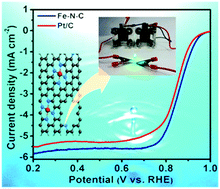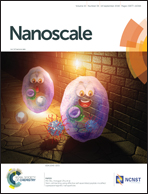A rationally designed Fe-tetrapyridophenazine complex: a promising precursor to a single-atom Fe catalyst for an efficient oxygen reduction reaction in high-power Zn–air cells†
Abstract
The development of low-cost and highly efficient single-atom oxygen reduction catalysts to replace platinum for fuel cells and metal–air cells is highly desirable but remains challenging. Herein, we report the fabrication of isolated single-atom Fe anchored on porous nitrogen-doped carbon from the pyrolysis of a well-designed solely Fe-tetrapyridophenazine coordination complex. The N-rich bridging ligand, tetrapyridophenazine (tpphz) is first employed as a spatial isolation agent of Fe that suppresses its aggregation during high temperature pyrolysis, resulting in highly reactive and stable single-atom Fe ORR catalysts. The catalyst shows remarkable ORR activity with a half-wave potential of 0.863 V versus the reversible hydrogen electrode (RHE) (21 mV more positive than that of commercial 20 wt% Pt/C) and excellent durability in 0.1 M KOH. Whereas in acidic media, the Fe single atoms also demonstrate ORR activity comparable to and stability much higher than those of Pt/C. Notably, Zn–air cells made using the as-prepared catalyst as the cathode provide a high open circuit voltage (1.53 V) and gravimetric energy density (947 W h kg−1), which are higher than commercial Pt/C based Zn–air cells (1.50 V and 828 W h kg−1). This work will open a new avenue to design single-atom catalysts for clean renewable energy storage and conversion devices.



 Please wait while we load your content...
Please wait while we load your content...